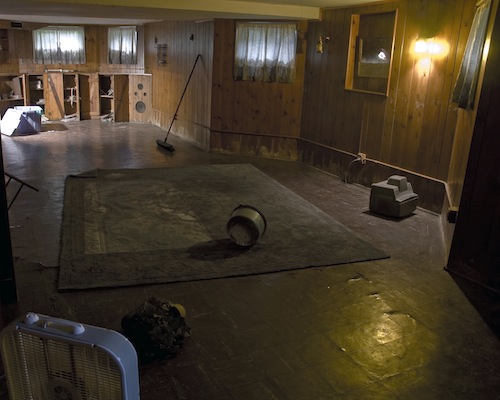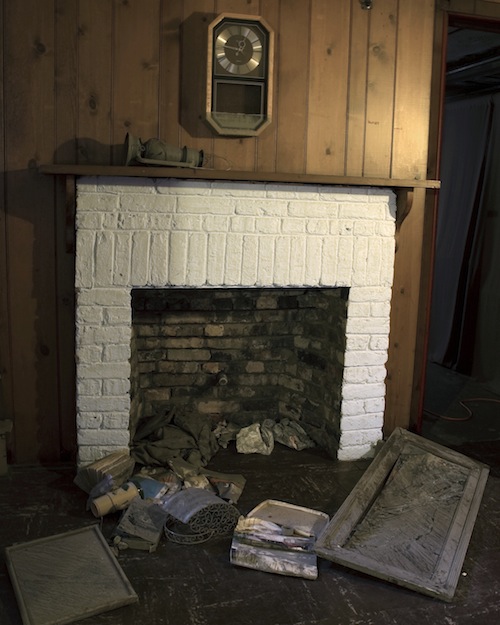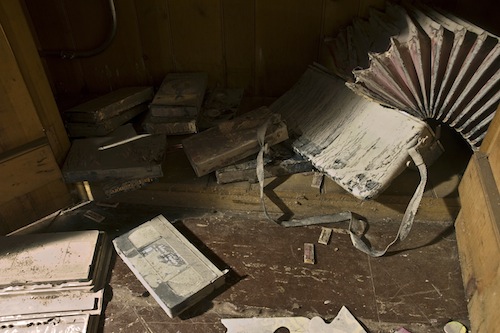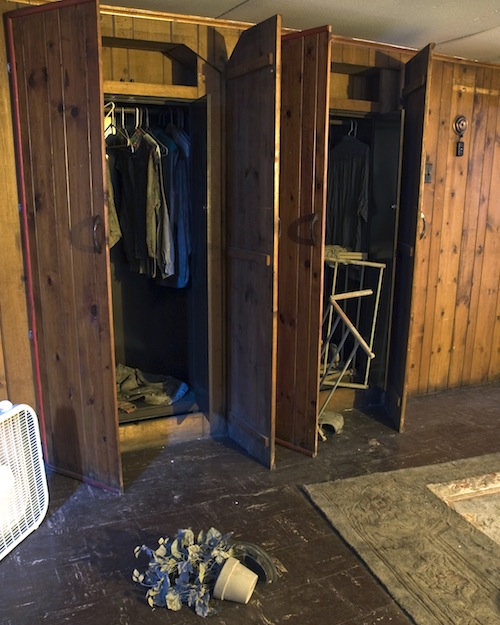
Heather Mekkelson. “Limited Entry,” 2008. Mixed media (soaked in clay slurry, particulates added, sealed). Old Gold, Chicago, IL. Courtesy of the artist.
It was the summer of 2008. It was hot. And humid. Everything was green and/or sweating. People who didn’t sweat stood out. Their reserve both enviable and mysterious—a contrast from everything else. Refuge from the heat was similarly impressive and constantly sought. Most apartment galleries were barely tolerable for their heat. At cooler exhibition sites, visitors inevitably took considerable time examining the works of art on display. That August, Heather Mekkelson had a solo show at an apartment gallery—or what maybe we should call a basement gallery—half a flight downstairs in Logan Square called Old Gold. With its dark 1970s style wood paneling, built-in bar and enough floor space for a pool table, Old Gold looked like an old rumpus room. It was anything but neutral and its unapologetic, undeniable character forced artists to continually incorporate the space into their exhibitions. Mekkelson’s project was no different. Limited Entry was based entirely on the unique environment. And at that particular time, it was significantly cooler than anything outdoors.
In order to access the stairs down to the gallery, one walked through a front gate and around the side of an apartment building. According to rumor, the landlord and upstairs resident did not know Old Gold existed. Being an unpredictable fellow, gallery directors Kathryn Scanlan and Caleb Lyons preferred to keep the professional aspect of their curatorial project discreet. They didn’t advertise much and the only label on the door was composed from Home Depot stickers, appearing more like the absent-minded work of a teenager than anything formally significant. This place was easy to miss.

Heather Mekkelson. “Limited Entry,” 2008. Mixed media (soaked in clay slurry, particulates added, sealed). Old Gold, Chicago, IL. Courtesy of the artist.
In the case of Mekkelson’s show, the landlord might not have recognized the installation as art, even if he happened to walk down the steps, through the back door and into the basement space. Mekkelson installed a series of everyday but nevertheless destroyed objects around the room. Observing these objects, he would have assumed they were damaged by water, and as a property owner, would have had to answer a number of questions about how and when whatever flood that damaged so much in the room had taken place. This would have been puzzling because there hadn’t been any real rain to speak of—and yet judging by the extent of the damage (he would have seen a water line around the room that suggested standing water as high as four or five feet) he would perhaps encounter that strange, uncanny sense that this crisis happened outside of his perception. Even the curtains were stained with a water line. He would have heard a whirring fan, presumably to dry out the damp. Aside from two small garden windows, the only light shone from a bright work light, set up on the ground. It reflected in a mirror, which, like the curtains, displayed the same water mark. A broom leaned against a wall, left with seeming purpose—as though its corresponding human went to pick up the phone for a moment. The built-in cabinets and closets stood half open. Once-soaked clothes hung on hangers, spoiled but not yet thrown out, as board games, equally distressed, spilled onto the ground along with a mud-spattered assortment of VHS tapes, a dead radio, an old pulp paperback, and a distended accordion-style file folder. These objects so perfectly mimicked the residue of a flood, it would be almost impossible to describe them as works of art. Particularly if you didn’t know you were standing in a contemporary art exhibition.

Heather Mekkelson. “Limited Entry,” 2008. Mixed media (soaked in clay slurry, particulates added, sealed). Old Gold, Chicago, IL. Courtesy of the artist.
If our landlord was feeling sensible, he might be impressed by the evident handling of the situation. The fact that no human was present gave the tableau a casual atmosphere. Yet evident steps had already been taken—the fan, the rug laid out to dry, the apparent sweeping of the floor. Things were under control. And then if one began to look more closely at everything, to take seriously the incongruity of this scene with the recent weather, and over all condition of the building, it would likely become more interesting. Because although these personal affects conspired to affect the aftermath of a crisis, in fact no such event could have transpired. While presenting hard, material evidence of a catastrophe, just before an imagined restoration of order, they ultimately resisted logic. Remember, it was hot outside. It was hot in the landlord’s apartment. Consequently he is inclined to take his time here. He might also have a touch of that too-easily stereotyped, masculine-identified trait: to get to the bottom of whatever transpired and fix it. Our landlord might wonder if he was in a dream at this point; feeling a self-awareness bubble up, hearing the bitter remarks of former lovers, or frustrated children. He might regard this scene with a sense of helplessness, suddenly. Realizing that this is the very scenario he cannot be useful within, having missed the initial trauma and now coming late. He has had this sort of dream before. Indeed, with three years of distance, his mind might be dredging up images of Hurricane Katrina, supposing for a split second that this illogical scene was the work of his subconscious, imposing a deep-seated fear onto his own, generally placid and very much Midwestern surroundings. He might pinch himself. Or turn the light switch off and on, school boy tricks he had all but forgotten. Maybe he laughed with renewed confidence; he is still simply in his apartment on a hot summer day. His tenants could just as easily be filming something. He knew they were artists; they were always unpredictable. Still, whether in a dream or a set, he would not deny that these things created a resonant field evoking a narrative, forcing the viewer to survey the scene like a forensics detective. At this stage, our landlord would suppose these things were lying.

Heather Mekkelson. “Limited Entry,” 2008. Mixed media (soaked in clay slurry, particulates added, sealed). Old Gold, Chicago, IL. Courtesy of the artist.
He would be right. Mekkelson imbues objects with an artificial memory. There was never any flood in this room; prior to their experience in Mekkelson’s studio, all of the objects were brand new. The distress they wear is therefore artificial, and yet once one draws that conclusion, the fabrication of distress becomes newly fascinating. Mud, dried in drips transforms a paperback book into an abstract composition. Each object, carefully rendered offers a unique meditation on corruption. The line of the watermark around the room boasts a bizarre authority—tying the mess together and thereby suggesting the inner logic of this still life. And is this kind of illusory composition so different from the exercise of perspective in a realist painting? Except in this case the art does not recreate a “real” scene (via painting or photography, for instance). Instead, Mekkelson’s “sculptures” must consume and destroy the real things they once were in order to become art objects. Once-useful objects must be rendered useless in their transformation into art. By firmly creating a sensation of flux—a room before it is put back together—Limited Entry suspends time. One’s ability to return to this room again and again over the course of the exhibit gives the viewer access to typically ephemeral, disembodied and often desperate moments of crisis. To contemplate the ensuing desire to move on and get things back to their proper place. To clean up the mess. Again, what might especially aggravate our landlord—a man who by his very profession hastens to maintain and fortify domestic security.
Images of Hurricane Katrina have joined up with the more recent footage of Japan’s 2011 tsunami, and Hurricane Sandy. Perhaps what is strangest about those historic events is that they are fleeting, leaving behind ghosts, mineral deposits, and technical difficulties. Despite the static network of objects, Limited Entry was, like any other show, even more ephemeral. Aside from an old listing on Artslant and a review in New City it has more or less disappeared without a trace. Shortly after the exhibit closed, signs of Mekkelson’s presence were erased—even that watermark disappeared. Old Gold doesn’t exist anymore either. It’s former directors have moved west, relocating to Los Angeles. Probably the basement has resumed its life as a rec room retreat. Perhaps the landlord has new tenants that exacerbate or sooth his disposition in turns. He might regard the residue of their backyard parties with similar suspiciousness, but likely thinks little of the basement flood he once thought he’d witnessed. Probably my recollection of this exhibit is off as well, with glitches, inaccuracies, and exaggerations due to time. Certainly my portrayal of the landlord is wrong. I never met him. I should add too, I don’t put much stock in the long-stale rumor about his disposition either. For all I know he came to every opening. What lingers for me, however, as a kind of auratic residue, is the idea that my own account for what took place is perhaps not so different than whatever story the objects in that room conveyed. Honest and false memories mix themselves up, without evidence to differentiate.




Pingback: Big and Bold : Bad at Sports
Pingback: Week in Review 06.01.13 | Art21 Blog